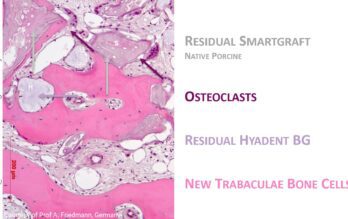- Dott. Fabio Bernardello, MD, DDS 1
- Dott. Giampietro Bertasi, MD, PhD 2
- Dott. Ralph Powers, DDS 3*
- Dott. Sergio Spinato, DDS 4
- Dott. Andrea Viaggi, DDS 5
- Dott. Jimmie Bullock, MS 3
- Dott. Pietro Felice, MD, DDS 6
- 1 Private Practice, Legnago (VR), Italy
- 2 University of Padua, Italy
- 3 Institute of Regenerative Medicine, LifeNet Health, Virginia Beach, Va
- 4 Private Practice, Sassuolo (MO), Italy
- 5 Private Practice, Florence, Italy
- 6 University of Bologna, Italy
Abstract
CASE DESCRIPTION
A 67-year-old female presented to the University of Ferrara clinic with leukoplakia at the retro-incisal area of the floor of the mouth. The patient was a nonsmoker. Existing mandibular dentition was in poor condition with no posterior occlusion to stabilize the arch. Initial workup and coordination of treatment was provided in a team fashion through the University of Ferrara (Ferrara, Italy) Department of Oncology. A biopsy evidenced squamous cell carcinoma of the floor of the mouth. Additional investigations were performed to determine the extent of cancer involvement to contiguous structures. After careful planning, the carcinoma was surgically removed with partial floor of mouth dissection. In addition, part of the vestibular portion of the mucosa was removed and a partial resection of the interforaminal portion of the anterior mandible (partial mandibulectomy) was performed. Healing was painful and complicated. Transient paresthesia of the lower lip (possibly secondary to stretching of the inferior alveolar nerve at the exit from the mental foramina) was noted following surgery. The paresthesia was still present after 2 years but widely regressing in severity. The surgery removed a wide area of soft tissues of the mouth floor and anterior vestibular area, causing the union of the vestibular floor with the lower lip resulting in difficulties with speaking, swallowing, and movement of the lower lip.
Video abstract
Introduction
Many dental procedures allow for implant placement in partially or totally edentulous patients. Despite the availability of various implant and abutment types on the market, it often becomes quite challenging to achieve the biological and esthetic goals in a patient who has ridge deficiencies.
Problems arise from the lack of adequate bone quality and quantity.
1,2 Soft tissue form and maintenance is also a consideration to evaluate.
3 Primary reconstructive techniques following segmental mandibulectomy is evolving and improves quality of life. A seldom encountered complication is the discovery and treatment of a malignant process (for example, squamous cell carcinoma). Oral squamous cell carcinoma (OSCC) is one of the most aggressive malignancies worldwide and accounts for more than 90% of all oral cancers.
4 It is ranked as the sixth leading cause of cancer mortality worldwide. The most common sites of OSCC are the lateral ventral surface of the tongue, the floor of the mouth and buccal mucosa. For most oral cavity cancers, surgery is the initial treatment of choice (often involving the full or partial removal of bony jaw structure).
5 Radiation or chemoradiation is added postoperatively if disease is more advanced or has high-risk features. Successful cancer therapy can affect the quantity and quality of soft tissue in areas where implants are planned, thus affecting the initial placement and the long-term success of the implants. Complications can be numerous; especially difficult is implant treatment in the mandibular anterior area where inadequate alveolar height results in the lingual floor and the vestibule becoming contiguous.
6 Further complicating treatment is the presence of scar tissue (often found following cancer surgery and radiotherapy).
The present case is a report of the combination of a soft tissue enhancement and implant placement following partial mandibulectomy resulting from the treatment of oral squamous cell carcinoma.
Download
Do you want to download the complete scientific article in .pdf format? Leave your name and e-mail address.
You will receive a confirmation email with the link to download.
Meer wetenschappelijke literatuur


